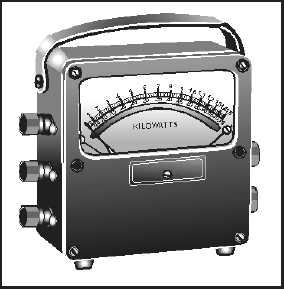3-13
ELECTRODYNAMIC WATTMETER
The electrodynamic wattmeter is used to measure power taken from ac or dc power sources. The
electrodynamic wattmeter, shown in figure 3-10, uses the reaction between the magnetic fields of two
current-carrying coils (or sets of coils), one fixed and the other movable. When the current through the
fixed-position field winding(s) is the same as current through the load and the current through the moving
coil is proportional to the load voltage, then the instantaneous pointer deflection is proportional to the
instantaneous power. Since the moving pointer cannot follow the rapid variations in torque because of its
momentum, it assumes a deflection proportional to the average power. The dynamometer-type wattmeter
automatically compensates for the power factor error of the circuit under test. It indicates only the
instantaneous power resulting from in-phase values of current and voltage. With out-of-phase
relationships, a current peak through the moving coil never occurs at the same instant as the voltage peak
across the load, resulting in less pointer deflection than when the current and voltage are in phase. The
simple meter shown in figure 3-10 is not compensated. When the load is disconnected, this meter will still
indicate that power is being consumed in the circuit. This difficulty can be eliminated by incorporating
two compensating windings, mounted with the primary fixed-coil current windings, as shown in figure 3-
11. These stationary windings are used to produce a magnetic flux proportional to the current through the
movable coil. As shown by the arrows, the currents through the primary movable coil and the
compensating coil flow in opposite directions, producing a torque caused by the opposing magnetic
fields. These opposing fields cancel. Hence, with the load removed from the circuit, the meter will
indicate zero power through the load.
Figure 3-10.—Typical electrodynamic wattmeter.

